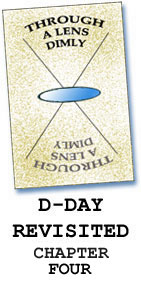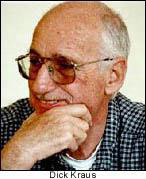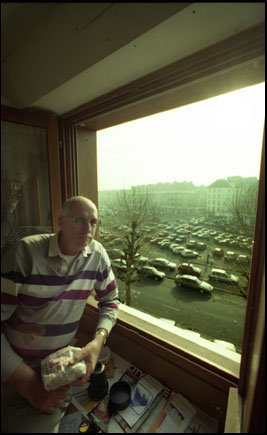PROLOGUE
I was twelve years old when the radio announced that the Allies had
launched the long awaited invasion of Europe that would ultimately
lead to victory and the end of World War II. That day was June 6,
1944 and would come to be known as D-Day.
This June will be the 60th anniversary of that historic event.
I beg your indulgence as I begin the story, about one of the greatest
assignments of my long career as a newspaper photographer.
D-DAY REVISITED
By Dick Kraus
Newsday
Staff Photographer (retired)
CHAPTER FOUR
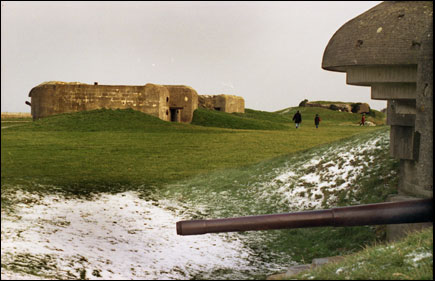
© Newsday Photo by Dick Kraus
A dusting of snow coats the ground at the German fortifications
and shore batteries at Longues sur Mer.
|
|
For the
next few days, Jim Kindall and I traveled up and down the coast
of Normandy in our rented car, trying to capture the the ghosts
and memories of that D-Day in 1944. As we walked along the
peaceful, hard packed sand of Omaha and Utah Beaches, we tried
to imagine what it must have been like almost 50 years ago.
It was now November and the cold wind blew in off the English
Channel and the light grew weak by early afternoon. It was
next to impossible to photograph anything that might resemble
what happened on that “Longest” summer day in ‘94. |
| I shot
frame after frame of anything that was left of the battles
and we would return to our hotel, long after dark, tired and
hungry. I would be bringing my unexposed film back to the paper
to be processed, but I spent long hours, each night, checking
my caption notes to make sure that I had all of the information
that I would need. Kindall did the same with his notes and
we would compare information and spellings to make certain
that both of our stories jibed. |
© Photo by Dick Kraus
(self timer)
I sit in the window of my hotel room, going over
caption information.
|
|

© Newsday Photo by Dick
Kraus
A souvenir stand sells D-Day memorabilia at Omaha Beach. |
|
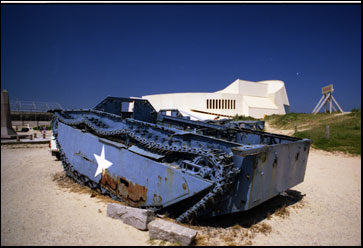
© Newsday Photo by Dick Kraus
A rusting hulk of a landing craft still sits on the sand
at Utah Beach. |
|
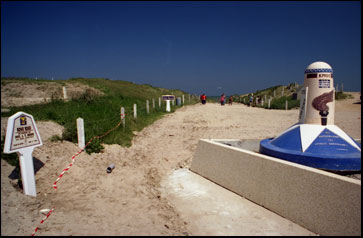
© Newsday Photo by Dick Kraus
Mile markers set up by the advancing Americans show the
slow and costly route inland from Utah Beach.
|
|
All
of our efforts on this trip were to be used in a special
edition about
D-Day that would run in the Sunday paper on the weekend before
June 6th, 1994; the actual 50th Anniversary of the invasion.
Kindall and I wouldn’t be there to see the results of our
work until later. We were going to be back in Normandy, a week
before June
6th, to cover the
special events that would take place to commemorate the invasion.
And those stories and photos would be filed and transmitted back
to our paper to be used on a daily basis.
But, for now, the story was just taking shape in Kindall’s
mind. Over late dinners, we would talk about what we did each
day and I would try to recall the photos that I had taken to
determine
which ones might be more relevant. Each day we would place a
call to our desks, just to touch base and let them know how the
story
was progressing.
I had arranged with the proprietors of our little hotel, to reserve
two rooms for us when we came back. We had learned that lodging
was almost non-existent in Caen or anywhere in Normandy for the
duration
of the D-Day Anniversary. Huge numbers of American veterans and
their allies would be flocking here for these ceremonies. Plus
there were
government and military officials and heads of state from the
allied countries, and their entourages and security who would
need accommodations.
Throw in a tremendous media presence and you had a huge demand
for every available nook and cranny. Our hotel hosts assured
us that
they would hold two rooms for us for the two weeks that we would
be back in Caen.
One night, we got back to the hotel earlier than usual and I
scoured the neighborhood to try to find a place where I could
get my film
processed each day, when we returned in June. Since I would transmit
my photos back to Newsday, each night, I would need a lab that
I could count on to be open late, when I returned from the battlefields.
I gave up on the first couple of film processing labs that I
tried, mainly because of language problems. My lousy French was
ok if
I was asking for directions to the bathroom, but to try to explain
that I would need them to stay open until I returned from the
field and that I only wanted the film processed without the need
for
prints,
was more than my weak French vocabulary could manage.
Quite frankly, I found that the French were rather standoffish.
I have traveled to enough foreign countries to understand that
being
an American isn’t the key to being liked or understood in other
lands. I’ve always despised being thought of as “The
Ugly American” and I’ve always made an effort to
appreciate the people and the culture of other countries. Whenever
possible,
I try to learn at least some basic words of the language wherever
I am. And, in most cases I am rewarded by the locals making an
effort to understand and help me. I have found that if I try
to speak the
native tongue, the locals suddenly speak English. But, with the
French, nothing that I could do would soften their obvious dislike
of Americans.
It was almost as though they resented the fact that their prestige
in the world had diminished and that the US, whom they had once
assisted in our War of Independence from the British, had now
become a world
power and had, in fact, twice come to their rescue in two world
wars.
I continued to try my hardest to be polite and civil, even in
the face of some outright rudeness. I finally found a small Fuji
shop
a few blocks away that was owned and operated by a beautiful,
young French woman with a lovely, lilting name. Marievann. She
spoke
English with a charming French accent and was pleasant enough
to smile at
my brutal attempts to speak her language. I explained who I was
and what I needed from her lab in the way of flexible hours.
I told her
that there would be many nights where I wouldn’t get back
to Caen until late in the evening and I would need to have my
film processed
while I waited. I offered to pay the expenses she would incur
by staying open late and we came to an amicable agreement.
She didn’t understand why I wouldn’t require prints
from my film until I explained that I would have a transmitter
with me
that would accept the color negatives that I would be shooting.
With that problem solved, I then purchased from her, several
lead lined
film bags, with which to bring my current collection of exposed
film safely through the airport X-Ray equipment.
| One day
we were put in touch with a Frenchman who, as a young boy,
had risked his life in the service of the French Resistance
during the German Occupation of France. We met André Heintz,
who was now 73 years old. He had operated as a courier and
took messages through enemy lines to other guerrilla units
operating in Normandy. I photographed him while Jim Kindall
took notes about his story. He described some of the ways he
and other partisans fooled the Germans with counterfeit identification
papers and documents. |
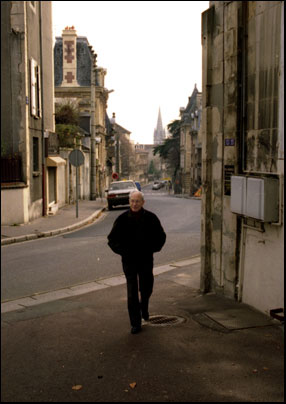
© Newsday Photo by Dick Kraus
André Heintz, a member of the French Resistance, walks
through the streets of Caen.
|
|
| He described
how they had made a simple short wave radio transmitter and
receiver and managed to conceal it inside of a can of vegetables.
Mind you, this was before the advent of transistors and miniaturized
electronics. I remembered seeing this apparatus on display
at the D-Day Museum in Caen, and I went there and photographed
it. |
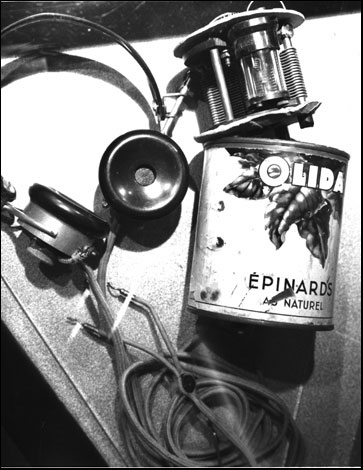
© Newsday Photo by Dick Kraus
The spy radio used by the French Resistance, on display
at the D-Day Museum in Caen.
|
|
The proprietor
of our hotel mention to us, one day, that there was another American
currently residing at the hotel. She
was young woman
who was an intern for the Fresno Bee in California. She was
in Caen as part of an intern swap and was now interning for a
local
French
paper. Interesting. Kindall and I looked her up and invited
her to dinner that night. We were dining with the lovely young
American
woman who was one of the administrators of the joint French-American
D-Day Museum.
We had a most enjoyable dinner and it was interesting to hear
how these two American women coped with working in this French
environment.
We also learned about the famed Beaujolais wine of the region.
I am not much of a wine drinker, but I learned that Beaujolais
was
a very seasonal wine and when the first of it appears in the
early winter, it is a much sought after commodity. So, of course,
we
ordered it with our dinner. I found it to be much too tart for
my taste, but
then, as I said, I am not a wine drinker
.
This day happened to be my birthday, and I did wind up drinking
more Beaujolais than I preferred, as my companions toasted my
health and
prosperity more than once. And, as it happened, the next day
was Thanksgiving. The American staff at the Museum was throwing
a Thanksgiving
party for the French staff and the Americans were cooking all
of the traditional holiday cuisine. There would be roast turkey
with
chestnut stuffing, yams, cranberry sauce, pumpkin pie and apple
cider. And, Kindall and I and the young intern were invited.
There was no day off for us, that day, however. Kindall and
I still had work to do. We ranged up and down the coast,
hitting more places that were important to the invasion.

© Newsday Photo by Dick Kraus
The graves of American GI's at the American Cemetery at
Colleville sur Mer. |
|
At Gold Beach,
which was in the British sector, we saw the rusting remains of
the Mulberry Artificial Harbor that had been
erected as a port
facility to unload the hundreds of ships carrying war material
to supply the invasion effort. These were huge, steel caissons
that
were constructed in England and towed across the English
Channel and sunk, one next to another in the shallow waters,
to provide
docks and ramps to allow trucks and tanks to offload from
the ships and
drive ashore.
Fifty years later, there were still several visible across the
hazy expanse of water. You could see whole sections rusted out
of their
sides and they undoubtedly now harbored schools of fish and other
marine life. On this overcast day, there were Frenchmen casting
their baited fishing lines from the shore.
In our travels, we passed through the picturesque village
of Port En Bessin, where at low tide, any boat in the harbor
is left stranded on the harbor bottom as the water ebbs.
OK, this place had no significance to the D-Day story,
but I had to stop and make some photos for myself
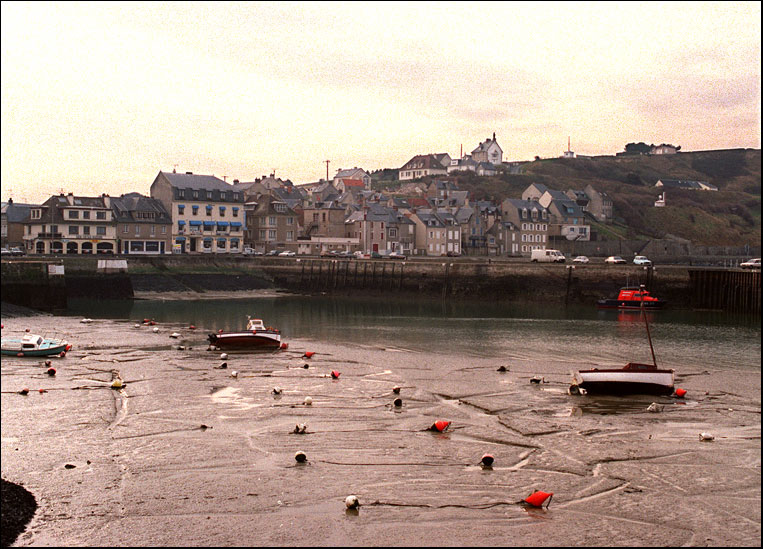
© Photo by Dick Kraus
Port En Bessin at low tide.
|
|
When we got
back to our hotel later that evening, we showered and dressed in
our finest and drove to the Museum to
enjoy our Thanksgiving
feast. The food was delicious and Kindall and I were
truly grateful for this opportunity to celebrate what is normally
a family occasion
with this newfound family of Americans and French.
The next morning, there was a package in front of the door to
my hotel room. It was a bottle of Beaujolais from our friend,
the
intern from the Fresno Bee. She had been sent to another part
of the country
and the wine was a birthday gift in appreciation of our friendship
for the past few days. Kindall and I shared it when we returned
to the hotel after a particularly long and grueling day.
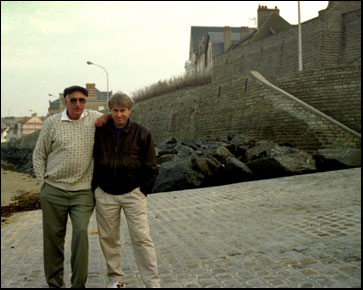
© Photo by Dick Kraus (self
timer)
Newsday writer Jim Kindall (at right) and I take a moment
to snap a souvenir photo in the coastal town of Arromanch.
|
|
After a few
more days, we took a train to Paris and boarded a plane for the
long flight home. The first half of our adventure
was almost
over.
CHAPTER FIVE COMING NEXT MONTH
newspix@optonline.net
